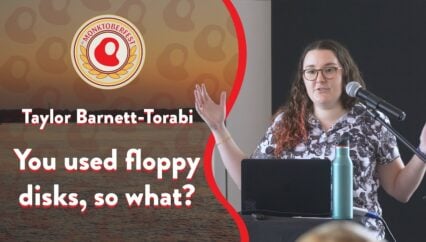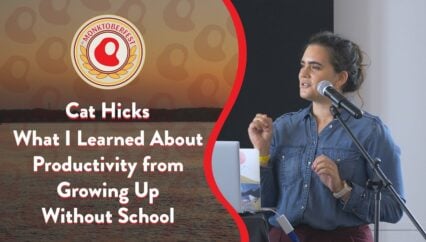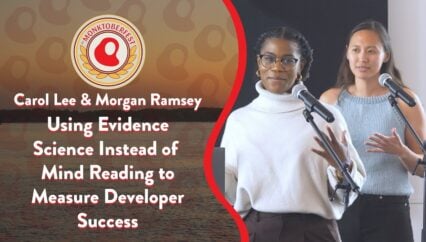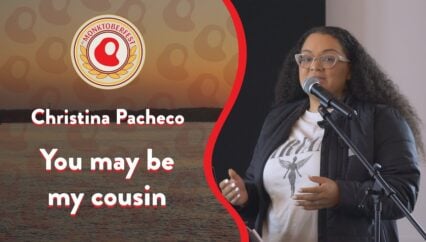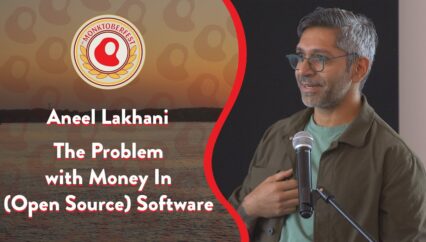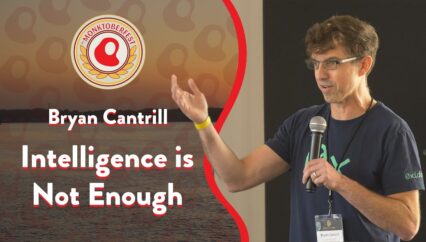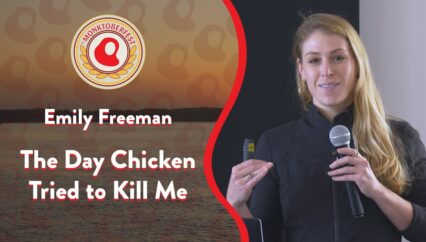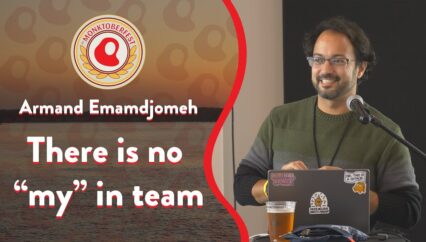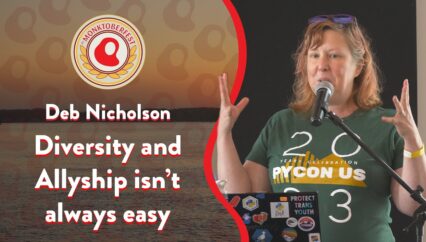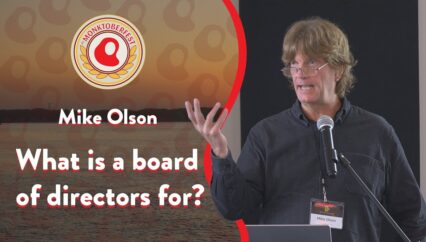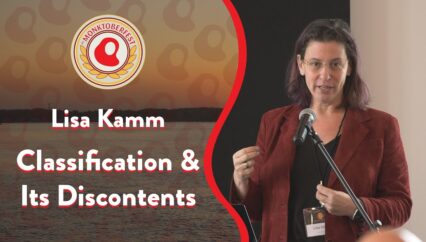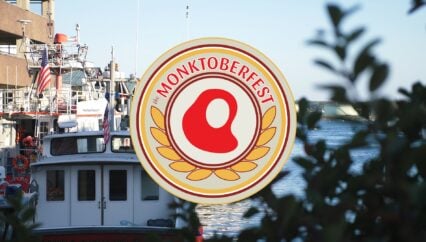Lasagnas might not seem to have much in common with the Monktoberfest, but it turns out that the lessons and values needed for an organization to make and deliver them at scale are eminently transferable to open source projects. As Lasagna Love has scaled to 100 volunteers and delivered a million lasagnas, this talk details the lessons learned when things grow faster than expected.
Transcript
This is my first public speaking since before Covid.
[cheering and applause]
I’m Erynn Peterson, what we’re here to talk about is a project called Project Ricotta and a nonprofit called lasagna love. I’ve been working on the internet since 1995. I’ve had some big projects, small projects, I used to run Microsoft’s open source foundation. I’ve won an O’Reily award for open source contributions, I’ve been a CEO at the dinner that Mike was talking about earlier this morning. So I’ve worked on some really cool projects, but Lasagna Love is probably — it’s definitely in my top three favorite projects.
Whenever I tell anybody about Lasagna Love whether it’s at a conference, whether I play trivia, family reunions, whatever it is, everybody always has the same reaction. The way Lasagna Love is, anybody who wants lasagna for any reason whatsoever, makes a request through the website and then somebody a couple days later, delivers a lasagna. Is that I have run projects that have hundreds of millions of daily active users and I have never been involved in bringing so much delight to the world.
When I first started doing this as a chef, you can sign up as a chef or as a recipient, and I think it was maybe the 20th person, it was started by a woman during Covid, she wanted a way to connect with her neighbors, and very quickly spread to Rhode Island which is where I lived, and I signed up to deliver lasagna, and about a week went by and I realized, they were really suffering some scale issues, that this was growing faster than they intended. And those of us who have ever been on a project that has grown unexpectedly quickly know that the only thing worse than a project failing is a project growing too fast.
And that’s a bit of what was happening here.
And so I called, and I had said hey, it looks like you’re having some scale problems, I’m pretty good at scale. Can I give you a hand? And she said yeah. So I started working with Lasagna Love, joined the board. Continued to, would on it. And there is a couple of things that are amazing about Lasagna Love, most importantly of course is these lasagnas magically show up at people’s doors. But it’s also an incredibly friendly organization, and it runs with distributed decisionmaking, it runs at incredibly low cost. The cost to deliver a lasagna is going down all the time. It’s incredibly efficiency organization and I think a large part of its efficiency comes from its kindness and how kind everybody is who’s involved in the organization.
Nobody signs up to deliver free lasagnas because they’re an ass. That rules out a whole bunch of people right out of the gate.
And because I think about scale and because I think about organizations, I think a lot about Lasagna Love. Why has this grown so well? Mathematically what is it about this model that is so interesting and takes advantage of some things that probably many of us in the audience know and understand about reciprocity and the effects of food membership and the map behind the number of kindnesses that have to occur in order to tamp down the number of meannesses, and in order to increase the amount of elasticity in human relationships that comes from everybody assuming that everybody else is trying to do their best, even when something goes sideways, and that has affected both with how I act with Lasagna Love as a board member and has also affected me as an engineering leader becaused on some of the things I’ve learned as I work on Lasag na Love. The impact has been huge. This is from our annual newsletter. There’s been over 500,000 lasagnas delivered, and over 50,000 active lasagna shelves. This organization is over 3 years old. Very few of the people get paid. It really does run on altruism. One of the things that I’ve observed about this organization is that it is an incredibly high-performing environment. People show up and they do their best. If you can’t deliver a lasagna coming up for whatever reason, people go into the tool and they just say, I’m not going to be available this week or I’m not going to be available this month and they just get taken off the schedule.
We run into a couple of really interesting problems on Lasagna Love. One in particular I doesn’t think any of us saw coming. The one that’s probably pretty obvious is, how do you scale a system that requires organization when you don’t have an engineering budgets. One of the less obvious ones that I’ll share with you that I continue to find fascinating is that a problem that has happened over and over again is we have too many people signing up to be chefs versus the number of people signing up to be recipients. So early on we spent some time thinking about how do we make sure that we have enough chefs for potential recipient. But what we discovered was, we had too many recipients. We had people calling and saying things like, hey, I signed up to make a lasagna a month ago and nobody has asked me for lasagna.
And so we created programs where you could take them to firehouses or schools or what have you and that’s how we started to get lasagna requests coming through the door.
And then something else that we learned is that — this is true of the US. I can’t really speak for a lot of other countries. In the United States, there seems to be a lot of pressure on people to justify when they’re asking for a nice thing to happen to them. And in particular, there seemed to be pressure on people to feel that they had economic need before requesting lasagna. And it could be because you’re tired that week, it could be because you have cancer. It could be because it’s the end of the month, you’re short on cash, whatever reason and the reciprocity in this model comes from both the person making the request, and the person who’s delivering it, because it is so much fun to show up at somebody’s door with a lasagna.
And we can only do to people that request it, right? So delivered a bunch of lasagnas at this point, and my very favorite was had this recipient, we were going back and forth on texts, it was kind of a hassle to communicate with them. It’s not usually a problem. It was sort of a hassle and after a couple of days I realized the reason it was a hassle, was because I was communicating with a 12-year-old boy.
And I was communicating with this boy and he was in school, right and 7th graders aren’t allowed to have their cell phones in the classroom.
So I’d have to wait until he showed up after school and had his cell phone and the reason that he was communicating with me was because his mother had died about six months before and his father didn’t speak English and so he was communicating for his dad for this lasagna. And the whole time this kid was like, there’s no way somebody is showing up at my house with a lasagna. But we’re a vetted organization, we’re an official 501(c)(3) organization and we showed up at this person’s house and I usually also bring a cake or something, and I brought the lasagna and he was like 6 foot tall, 12-year-old kid comes to the door and he had the biggest grin on his face and his dad was right behind him. He’s like, I cannot believe that this is actually a lasagna showing up at the door and it was hard to decide who was more delighted in this moment. Whether I was more delighted or this 12-year-old kid was more delighted at the lasagna showing up at his door and so in order for the reciprocity to occur we really had to start breaking it down and making it easier for people to just say, if any of you would like a lasagna, go to lasagnalove.com and request a lasagna.
One of the reasons that this organization has been able to scale was so relatively low friction is that there is a clear set of core values that have been articulated since probably the first or second month. And one of the reasons that this had to be written down to be communicated is that so many people were signing up so quickly that that was the only real way that we could train people in our community core values. And something that we would run into is that we would add essentially cohorts of new chefs, we had a set of new chefs come on board and somebody would inevitably say, wait a minute, how do I know that this person deserves a lasagna? And after the first few rounds of this, we documented that everybody deserves a lasagna, right? Everybody deserves a lasagna. It’s about your internal assessment of do I want to make a lasagna this week or not. And so this became part of the values that were communicated across the entire organization and also very quickly we articulated a mission statement and emphasized that this is about spreading kindness. It’s not about food insecurity. It’s not about poverty or judgment or anything else, this is simply about spreading kindness and creating and strengthening community, and if we remember back to what it felt like, in the middle or the tail end of Covid, having that opportunity to help strengthen the community was really meaningful and continues to be so.
Something else that I find totally fascinating that I suspect a lot of people in this room will also find fascinating is that we recently lifted the data of the people associated with Lasagna Love, so we’re now in three countries, when we looked across the United States, we’ve been signing people up for almost three years. And we’ve been looking at the political inclinations. It is nearly 50/50 Republican/democrat, which to me blew my mind because we have managed to create an organization where we are strengthening community and nobody is ever, ever talking about politics and it is pretty cool.
Because we have these values in place, we’ve able to start to build an organization where people know what the rules are. This is Burning Man. The cars are moving. We were able to build an organization where the norms are understood and people know — people know how to move toward the exit. People know how to cooperate with each other and make sure that something happens for the greater good, in a way that is relatively satisfying to everyone.
Interestingly, does anybody know where the term backscratching comes from? One of the interesting things that I’ve learned and relearned as an engineering leader is that when there’s a leadership vacuum, people will step up and start to act in unexpected ways. So where the he were it backscratching comes from is that in the old days when people were traveling by ship, it was really important that the person who was on the bow at night was sober and when they weren’t sober, that’s not a judgment on my part, it’s just the judgment of the guy who’s supposed to be watching for other ships, if they the person wasn’t sober, they got punished, and the punishment was you got lashed to the mast and got whipped. Apparently enough of these people happened that there was sort of a system that if you it was your turn to do the whipping, you’d whip lightly. You’d scratch the back, that’s where the term backscratching comes from, and it’s an example of where collaboration can arise and lead people to a outcome that you were trying to avoid as a leader.
And it’s a clear sense of mission, to sort of keep everybody on track.
The rest of this is a story of where that did not happen. And that is Project ricotta. So when an organization is growing this fast, you’re reliant on technology to keep it growing efficiently, especially people on the internet and the systems that were built three years ago when Ricotta Love was really really small. We needed to build a new set of systems to handle both the recipients and the traffic. And also of you may have noticed this, donations last year for most nonprofits fell off the cliff sometimes in January and March. And also Amazon Smile shut down so a lot of nonprofits have really been struggling this year. So we had to build a new stack.
Some of you might see where this is going.
If you’ve been in open source for any period of time — I see two people laughing already. You have heard somebody say to you, why don’t we just open source it? People will just show up and help us build it.
And so I was sitting in a board meeting and somebody said, well, why don’t we just open source it, and I could feel my eyes blink faster, right? And I said, well, it’s not quite like putting on a show, you don’t just say, hey, we’re doing an open source project and then have people show up. But I also realized that we needed to figure out some way to get this built, and it is Lasagna Love and people love it. So we need to do two things. So I called a couple of people and we put it out on LinkedIn, put it out in a couple of coding nonprofits, and said, hay we’re going to have a hackathon next weekend, see where this goes, this was on a Wednesday and I was thinking I’d probably get four or six people available next weekend. I didn’t check my email. Checked on Friday and we had 78 people signed up.
This never happens!
I was completely unprepared for it. As was the rest of the team.
And as I think I mentioned before, for any of us who have worked for any period of time, we know the only thing that is as painful as failure is unexpected success. These two things are equally painful.
And so we found ourselves by the end of the weekend with over 100 people signed up for this open course project that did not exist.
It exist in a Google Drive, my Google Drive, just a personal Google Drive and so we went ahead and tried to figure out how are we going to do this? And this is where some of these lessons started to come in.
I would say the results were mixed in how well we did. For people who had been on open source projects, they were able to very easily find their footing, they were very comfortable with the lack of documentation, I’ve been in a place with lack of documentation before, I’ve been in a place without a jury, but for a lot of people that was their only what do you mean there’s no GitHub? What do you mean there’s no repo? Who’s going to read my code? Where are my automated tools? And for those people we had to say, they don’t exist yet. We have to build them. And so it became a rollercoaster and we lost some people at this stage and I think for any project, particularly an open source project when you signed up a lot of people and you’d lose some people, particularly for a place like Lasagna Love, where our mission is to make sure people feel included, it was really painful, and so as a leadership team on a project, we stepped back and we thought about how we move forward from there, and there were two places we pulled from. One is a mission, and the values that we had already established within Lasagna Love. We knew we wanted to create a high-performing environment. We know, as do all the other engineers in the room, that the behavior you’re encouraging should be measurable and observable. We knew that we had to make coordination, norm enforcement easy. we had to make it easy for people to communicate and how to communicate expectations, how we were going to do pull requests, what the documentation needed to look like, what — we also open source code development was incredibly useful. I reread it last week before we did this. It still holds up. Some of the communication stuff is different, but principally it still holds up.
So we began to build out all the things you needed on an engineering team to have a high-performing engineering project.
For those of you who have only worked on great engineering teams and I’ve had a chance to work on some great ones. I worked at Amazon in the ’90s, I worked at Microsoft on a couple of great projects. It’s really easy to believe the myth that a great project is comprised exclusively of 10X engineers. But what you learn after you’ve been in a lot of different projects, is great engineering arises because the conditions for great engineering are put in place.
And sometimes, that’s about having great engineers. But having great engineers is never enough. You need the communication pathways, you need the documentation. You need cultural norms around things like how fast a pull request can be responded to. You need to have all the conditions in place to do great engineering and that’s what we started to do here on Project Ricotta. Something that helped us is of that 100 or so engineers, for some reason about half of them were infrastructure engineers and devops engineers and developer tools engineers, which never happens in an open source project and we’re incredibly grateful that it happened in this one and so we built out the infrastructure for really great engineering to occur, and we started moving forward.
As we started moving forward, we then discovered something else interesting. It was very Lasagna Love-like about this project. Because we had so many people signed up and because Lasagna Love always worked hard to find people in the community, you signed up as a recipient, we find you a chef, you sign up as a chef, we find you a recipient, we went really hard to find footing for people, we created the documentation, really Jira tickets and we realized we had to have some leaders in place. And we identified the people who were clearly leaders and we went to those people and we’re like, hey, you’re a leader, would you like to help us lead this project? And several of those people said, but I’m not a leader. I have not been promoted at my company or you know, I don’t have the degree or what have you, and you know, I was in the middle of this ridiculous open source project that was progressing much faster than it had any right to. And my response was, well, people will follow you. If people are following you for better or worse, you’re leading? The converse is also true. If you’re saying you’re a leader and nobody is following you, you’re not a leader.
And so we have this set of people, some of whom were new leaders and some of whom were experienced leaders and we put them together and that became the leadership team of this project.
And that’s when we made the next big leap that really makes a difference with Project Ricotta versus some other open source projects we’ve been on. We developed a list of job codes, same as anyone need at any company, junior dev all the way up to senior architect, all the way up to CTO. We were have clear of the expectations that we needed to see from any person in any given role, when we put a Jira ticket in, we’d try to code it and then we let people put that on their LinkedIn profile. Last year, when so many engineers were being laid off, the most painful thing to watch was not actually people trying to find new jobs as painful as that was. The most painful thing to watch was that there were people, engineers, who had built these long relationships with other engineers, within their private company, and they were used to communicating with Jira, or they were used to communicating in Slack.
And when they left the company, and they lost access to these communication tools, they lost these relationships. Around that was incredibly hard to watch and so Project ricotta, one of the things that we made sure is that everybody had hair footing and had a role and what was quickly translated to was people who had not been able to demonstrate within a corporate environment growth on a project, that they themselves had figured out how to do personally on the side, suddenly had this active repo, that they could point to and they could say, I did this thing and it performed to this degree.
And we found that some people were able to maneuver their careers in a whole different direction because we created space and opportunity for them to do that on Project Ricotta. And it also resulted in a much higher performing project as a result of the engineering leadership that we put in place.
One of the things that I encourage people to do is to find space on the team that you’re building for contributions to commit that are going to help you move your goal forward and sometimes these are going to come from really obvious places and sometimes they’re going to come from less obvious places, and in the past I’ve gotten push-back from some of my engineering managers and directors about taking the time to build out the tools of communication pathways to include other people. What I have found time and time again is when communication, pull request response times it improves not only the experience of the less experienced engineer, but it dramatically lowers the friction from the most valuable engineers to participate. It is a net gain, and it allows you to build teams that experience much less friction, small or complicated.
And the thing about big teams if you want to build a small, elegant project of your own, and I’ve seen some beautiful ones, you don’t to worry about communications, you don’t have to worry about incorporating and including people in the same way, but I think most of the people who are in this room are in this room because you like to build big things, because you like to be part of big interesting projects and that is how these big interesting projects get done is by allowing people to participate in a way that brings them a tremendous amount of joy in association with the mission.
There aren’t a lot of other missions that on the surface are as immediately — hey we’re trying to scale up delivering 2.5 million free lasagnas to 25 million free lasagnas, are you on board? People raised their hands for that.
As we edge into Hacktoberfest, we expect this be fully in production by November and in contrast to where we were, we kicked this project off five months ago and I said, sure I’ll put something out there and we will see who signs up we are a ready to go open source project, also see and measure the effect of the work that they’ve done, and that is the hallmark of a great engineering team and a great engineering project and we’re all very proud of what we’ve accomplished in this.
[applause]
